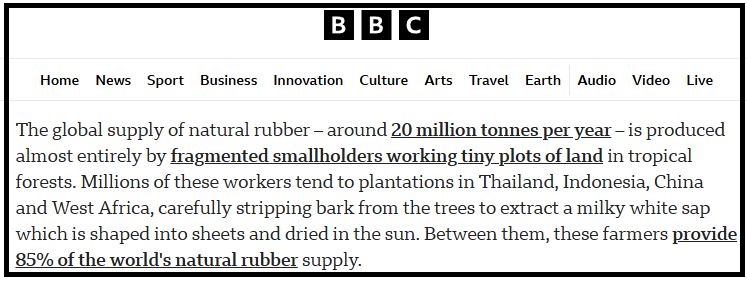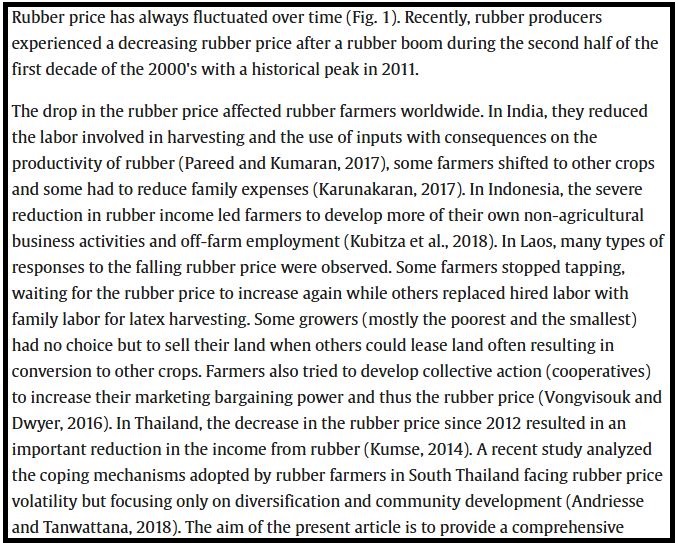Rubber is a material with a wide range of applications in various industries such as automotive, construction, apparel, household, consumer goods etc. Natural rubber is obtained from the latex of the rubber tree, and so, like cotton, it is a product of agriculture. While many products have seasonal pricing, when it comes to agriculture, things work a little different.
I have been very busy during this period, hence the slow update of articles. I note that in this article, my writing is not as smooth as the previous ones and content is not as expansive as the past. However, the critical and important points have been conveyed across, and for now I will not be spending too much time to improve the readability of this article.
In farming, crops generally have a seasonal price cycle, of which a big factor is the decision of the farmers on what to plant for the next year. Farmers do not necessarily have to plant a single type of crop in their fields. They have options, which are generally affected by the prices of the crops for that year. For example, garlic is planted and harvested once per year. Hence if the price of garlic is very high this year, many farmers will decide to plant garlic for the next round and a year later, prices will drop drastically due to oversupply. The converse also holds true.
Previously, we looked at sugar. Today we look at rubber. Core resources which are critical for a country’s survival and development is one of my areas of interest because of its inelastic demand and because of the resources certain countries will pour into it to ensure self-sufficiency.
From the chart below, we can see that the price of rubber has been on the lower end of the spectrum for quite some time. We will reference this in the later paragraphs.

Rubber Trees
Unlike garlic, which can be grown or harvested in a year, rubber trees are planted and reach maturity after about 6 or 7 years, and achieving peak production about 13 years after planting or 7 years upon the first harvest. If 2011 was the peak of rubber prices, it would be natural to assume that many would start to plant rubber trees around that time. That being said, it is not as if once the plantation is used for rubber trees, nothing else can be planted. Intercropping is a fairly common practice during the rubber tree immature phase, where farmers plant other short-term crops such as ginger, maize, banana, pineapple in order to supplement income during the period of growth. Intercropping is then generally stopped once rubber trees reached maturity in order to prevent competition for resources among the plants.
Global Supply
85% of the global supply of natural rubber is produced by small time farmers in their small plantations, hence their farming decision impacts prices significantly. Unlike big companies, these farmers often do not have a strong educational background and foresight on future prices, focusing instead on the short-term situation. We also have to note that many of these farmers are not well-off, so they do not have the capacity to tank prolonged periods of low rubber prices.

Impact Of Low Prices
As a result, when prices fall, farmers generally choose 2 of the following options:
- Tapping the rubber tree more to extract more latex to compensate for the loss of earnings, resulting in the weakening of the tree.
- Switching to other crops, which will fight for resources from the rubber tree. Neglect to the rubber tree is also an expected consequence. In the worst case, rubber trees are even cleared to make way for other crops.
It is important to note that for small time farmers, their labour and resources are limited. Even if they do not cut down the tree, even if the right intercrop will be beneficial for the soil and the ecosystem, there is only so much time and labour they can allocate to the plantation. When all is well, they can hire additional labour to tap the latex from rubber trees, but when things are not rosy, additional labour are no longer employed and the farmers’ families work on the crops themselves.

All of the above will only result in one thing – the rubber trees the farmers have planted will not provide the expected yield. Farmers will not feel it when prices are low and they have no capacity to tender to the rubber trees. But when prices start to go up and they intend to switch back, they will realise that their trees have become older and weaker, unable to generate as much latex as they have hoped. Even if the tree is still there, it is not as if they will go back into 100% production capacity any time they want.
Farmers will also need reaction time – in addition to realising that the time has come to switch back to rubber production, they will also need time to clear out the intercrops to focus on latex harvesting, getting ready the tools and the labour for it etc. All these while, rubber prices will only continue to go up in the event of a supply crunch. But why will there be a supply crunch?
The Current Situation
The current global supply for rubber is gradually unable to keep up with the demand. This is due to lesser planting of rubber trees and scaling back of rubber production over the past few years. Do take note again that unlike garlic (one year per cycle), rubber trees take time to grow. Existing trees can cater to current demands, but if no new trees are planted to replace the existing dying trees due to natural attrition, when the shortage is felt, all is too late. Just like how it takes time for the shortage to be felt, it too will take time for the supply to catch up with the demand. And therefore, we can expect a surge in the price of rubber some time in the future. How fast it will come, I do not know. But given the current situation, we should expect a general uptrend in rubber prices for the upcoming years.

The poor farmers, who had no idea what is going on, will then realise that rubber production is lucrative once more. They will squeeze their pockets and again make a decision to plant rubber trees in the hope that once the trees mature, they will be able to sell their latex at high prices. But as we now know, rubber trees take time to grow. And when everyone does the same thing, a few years later when the trees are ready, there will be an oversupply and the whole cycle repeats.
Next Article
Rubber prices have fallen over the years, and I believe we are at the tail end of the cycle. In the next article, we will look at the potential opportunities and how we can capture this trend for the next few years.
Showing 1 - 3 out of 3
Page 1 out of 1
| - | Shop Products | Price | |
|---|---|---|---|
|
|
$99,999.00
|
||
|
|
$1.00
|
||
|
|
Price range: $69.00 through $99.00
|


